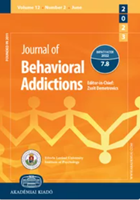Regional brain activity of resting-state fMRI and auditory oddball ERP with multimodal approach in individuals with internet gaming disorder
Regional brain activity of resting-state fMRI and auditory oddball ERP with multimodal approach in individuals with internet gaming disorder
Author(s): Joon Hwan Jang, Minkjung Park, So Young Yoo, Areum Choi, Heejung Kim, Jung-Seok ChoiSubject(s): Clinical psychology, Behaviorism, Substance abuse and addiction, Health and medicine and law
Published by: Akadémiai Kiadó
Keywords: amplitude of low frequency fluctuation; auditory oddball event-related potentials; fractional amplitude of lowfrequency fluctuation; internet gaming disorder; regional homogeneity;
Summary/Abstract: Background and aims: Resting-state brain activity may be associated with the ability to perform tasks; however, a multimodal approach involving resting-state functional magnetic resonance imaging (fMRI) and event-related potentials (ERPs) has not been widely used to investigate addictive disorders. Methods: We explored resting-state fMRI and auditory oddball ERP values from 26 with internet gaming disorder (IGD) patients and 27 age- and intelligence quotient-matched healthy controls (HCs). To assess the characteristics of resting-state fMRI, we calculated regional homogeneity (ReHo), amplitude of low-frequency fluctuation (ALFF), and fractional amplitude of low-frequency fluctuation (fALFF); we also calculated the P3 component of the ERPs. Results: Compared with HCs, the individuals with IGD exhibited significant decreases in ReHo and fALFF values in the left inferior occipital gyrus, increased ReHo and ALFF values in the right precuneus, increased ALFF in the left superior frontal gyrus, and lower P3 amplitudes in the midline centro-parietal area during the auditory ERP task. Furthermore, the regional activity of resting-state fMRI in the right inferior temporal gyrus and the occipital regions were positively correlated with the P3 amplitudes in IGD patients, whereas ReHo values of the left hippocampus and the right amygdala were negatively correlated with P3. Discussion and conclusions: Our results suggest that IGD patients have difficulty interacting effectively with cognitive function and sensory processing, although its interpretations need some cautions. The findings in this study will broaden the overall understanding of the neurobiological mechanisms that underlie IGD pathophysiology.
Journal: Journal of Behavioral Addictions
- Issue Year: 12/2023
- Issue No: 4
- Page Range: 895-906
- Page Count: 12
- Language: English

